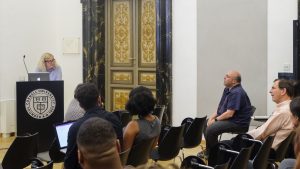Last week, we had the treat of welcoming Loretta Lees to our lecture hall. Lees is a professor of human geography, specializing in gentrification, public policy, and is actively engaged in community struggles of displacement.

She explained that the term “gentrification” was coined by Ruth Glass in London when the middle class was taking over working-class quarters, a process that continues until the entire area is completely changed. Lees said London (as well as places like San Francisco) are in hyper-gentrification, which means that there are extremely high land values, speculation, money laundering, and overseas buyers/investments.

She discussed William Julius Wilson, who wrote The Truly Disadvantaged, wanting to bring back the middle class (aka gentrify the city), which led to HUD’s HOPE VI program (Home Ownership & Opportunity for People Everywhere). In mixed communities, this resulted in social cleansing and gentrification, a major irony in reference to the program’s intention. The working class faced either replacement or displacement in London. The result? A huge division between upper middle class and low-income groups.

In a large-scale data collection, Lees discovered that since 1997, there have been 54,263 units have been demolished or slated for demolition on council estates of more than 100 units in London. She used the Heygate Estate as an example. In their process of regeneration, they screwed over all 3000 tenants, who were kicked out and forced to find housing, many of whom had to leave London. Displacement affects people on social, cultural, economic, health and schooling levels. The impacts are immense.
Finally, she discussed the fight-back. She stressed that local network organizing and self-organized activities are greatly influential, and that legal battles have been and can be won. The final message? Stop gentrification!
Sabine Strauch
